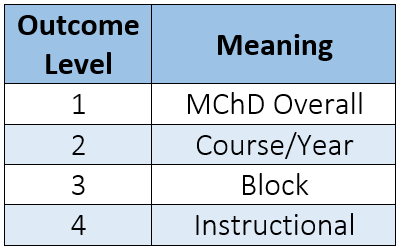Level 3 Learning Outcomes – Block 4 (Neuroscience and Musculoskeletal)
Outcome 3.4.1: Outline the functions of the peripheral nervous system (PNS), and describe and analyse disease states that affect those functions.
Outcome 3.4.2: Explain the structure and function of the components of the musculoskeletal system and its common pathologies.
Outcome 3.4.3: Integrate knowledge of the musculoskeletal system with an understanding of basic medical sciences and clinical skills, to interpret items of the clinical history, examination, and investigations to formulate diagnoses of common pathologies of the musculoskeletal system, and describe these in the context of the individual patient.
Outcome 3.4.4: Explain the classes and mechanisms of action of anti-rheumatic agents, immunosuppressives, psychotropic drugs and drugs used in pain management.
Outcome 3.4.5: Apply principles of immunology to investigate immune-mediated autoimmune disease using routine diagnostic laboratory tests.
Outcome 3.4.6: Describe the anatomy and common pathologies of the eye and related structures, retina & visual pathways, and explain the principles of formation and perception of a visual image.
Outcome 3.4.7: Outline the anatomy and functions of the central nervous system (CNS) and the roles of transmitters, synaptic plasticity, and networks in normal sensory-motor processing and in higher functions including learning and memory.
Outcome 3.4.8: Discuss the organization of the major sensory (somatosensory, visual, auditory) and motor (corticospinal, rubrospinal, reticulospinal) pathways of the CNS, and describe the organization of the major regulatory (basal ganglia and cerebellum) and neuromodulatory (brainstem catecholamine) systems and their functions in regulating behaviour and mood.
Outcome 3.4.9: Apply a knowledge of CNS structure and function to analyse, interpret and predict signs and symptoms resulting from common CNS disorders, or from site-specific CNS injuries including stroke.
Outcome 3.4.10: Apply a knowledge of tissues to analyse and explain the pathophysiology of common conditions affecting the CNS, the eye and the musculoskeletal system.
Outcome 3.4.11: Explain how microorganisms cause infections of the central nervous system.
Outcome 3.4.12: Analyse, evaluate and incorporate information from various sources to identify social, ethical, legal and human rights issues of presented medical cases in the context of global health issues including the ethical conduct of clinical trials, impact of trade agreements, pharmaceutical and insurance industries as well as new technologies (such as nanotechnology and artificial photosynthesis) on sustainability of a safe and healthy environment and health system quality and equity.
Outcome 3.4.13: Demonstrate a capacity for reflective practice on the ideas and principles that drive collaborative practice with disciplines working together for health outcomes.
Outcome 3.4.14: Discuss health systems, and scrutinise new developments, including health economics; interpret epidemiological studies in understanding the burden and risk factors for selected neurological and musculoskeletal diseases.
Outcome 3.4.15: Obtain a history from patients whose presenting complaint(s) suggest(s) a disorder of the nervous and/or musculoskeletal systems to elucidate the cause of the illness and its impact on well-being and define the biological, social and psychological context of management; demonstrate system specific physical signs and interpret them in physiological and pathological terms; integrate clinical pathology, clinical physiology and imaging investigations with history and physical signs.
Outcome 3.4.16: Further develop clinical reasoning skills in Problem Based Learning cases through the integration of information from lectures, practicals and clinical skills, and consideration of population health and social aspects of musculoskeletal disorders, CNS injury and neurological disease.







